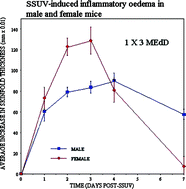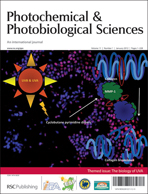Gender differences in UV-induced inflammation and immunosuppression in mice reveal male unresponsiveness to UVA radiation†
Abstract
Immunosuppression attributed mainly to the UVB (290–320 nm) waveband is a prerequisite for skin cancer development in mice and humans. The contribution of UVA (320–400 nm) is controversial, but in mice UVA irradiation has been found to antagonise immunosuppression by UVB. In other studies of photoimmune regulation, protection mediated viaoestrogen receptor-β signalling was identified as a normal endogenous defence in mice, and was shown to depend on UVA irradiation. A gender bias in photoimmune responsiveness was thus suggested, and is tested in this study by comparing the UV-induced inflammatory and immune responses in male and female hairless mice. We report that male mice, which show greater skin thickness than females, developed a less intense but slower resolving sunburn inflammatory oedema, correlated with reduced epidermal expression of pro-inflammatory IL-6 than females following solar simulated UV (SSUV, 290–400 nm) exposure. On the other hand, the contact hypersensitivity reaction (CHS) was more severely suppressed by SSUV in males, correlated with increased epidermal expression of immunosuppressive IL-10. Exposure to the UVB waveband alone, or to cis-urocanic acid, suppressed CHS equally in males and females. However, whereas UVA irradiation induced immunoprotection against either UVB or cis-urocanic acid in females, this protection was significantly reduced or abrogated in males. The results indicate that males are compromised by a relative unresponsiveness to the photoimmune protective effects of UVA, alone or as a component of SSUV. This could explain the known gender bias in skin cancer development in both mice and humans.

- This article is part of the themed collection: Biology of UVA

 Please wait while we load your content...
Please wait while we load your content...